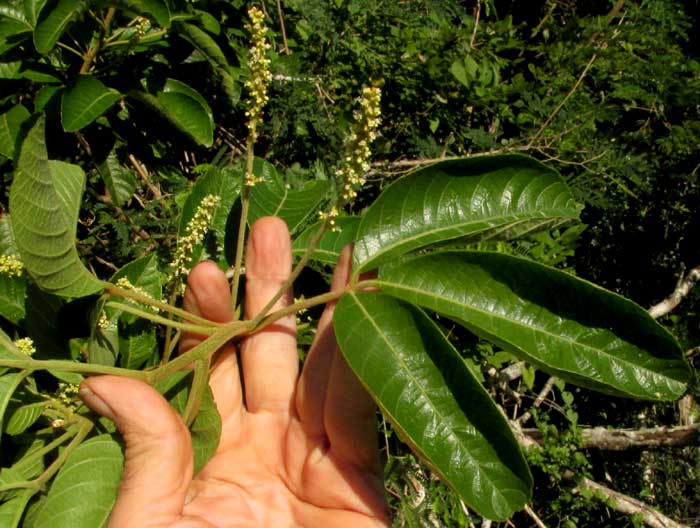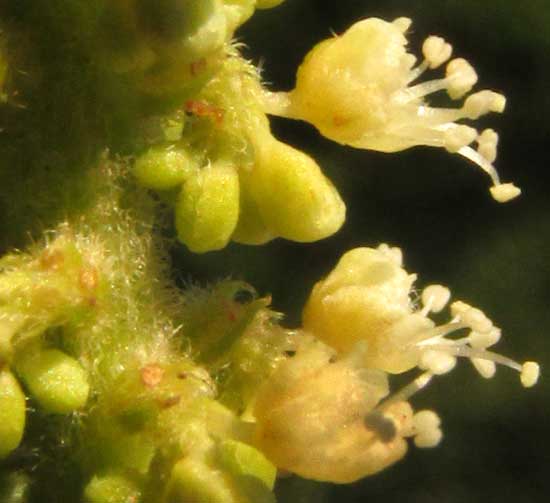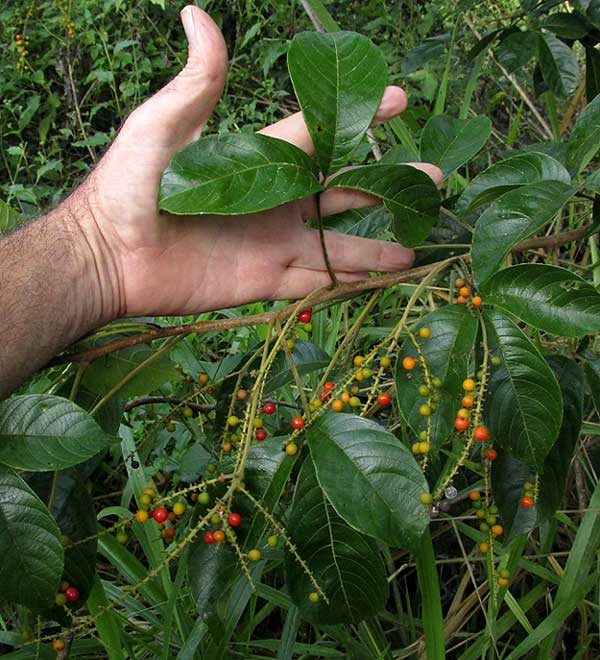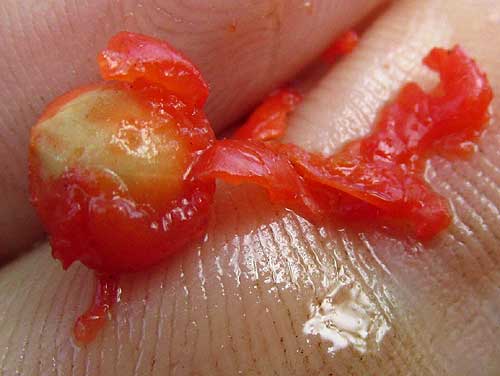Excerpts from Jim Conrad's
Naturalist Newsletter
from the November 23, 2018 Newsletter issued from Rancho Regenesis in the woods ±4kms west of Ek Balam Ruins; elevation ~40m (~130 ft), N20.876°, W88.170°; north-central Yucatán, MÉXICO
PALO DE CAJA FLOWERING
Each Sunday morning during my fruit-buying bikeride to Temozón I enjoy seeing how the roadside vegetation has changed during the previous week, and always there's the possibility that something new will turn up. This week I'd already passed a certain blooming plant when something about its appearance began gnawing at me. I went back for the closer look shown below:

The spike-like raceme of tiny, white flowers arising from vegetation velvety hairy on its stems, petioles and leaf undersurfaces is a combination of field marks shared by numerous common species here, especially the several weedy species of Croton in the Euphorbia Family. From the bike, I'd assumed that that's what we had here. But, no Croton has compound leaves with three distinct leaflets like these.
Up close, the spike-like raceme of seemingly unisexual male flowers still looked a lot like Croton, except that these flowers are vaguely two-lipped, the lower lip longer than the upper, and the stamens appear to be of different lengths, as shown below:

There you can see how very hairy the raceme's rachis is. Leaf bottoms are just as velvety, as shown below:

In short, here I had to "do the botany," since I couldn't think of any species with such flowers, and bearing very hairy compound leaves of three leaflets. Such trifoliate leaves are simply absent from the vast majority of plant families.
Our roadside plant turned out to be ALLOPHYLUS COMINIA, a member of the tropical Soapberry Family, the Sapindaceae -- which produces many species with compound leaves, but in that family such spike-like flowering clusters are rare. Knowing that, in the species' technical description I read that Allophylus cominia doesn't bear unisexual flowers, but rather the species is "polygamo-dioecious," meaning that the individual plants bear flowers that functionally are one sex or the other, but a few blossoms of the opposing sex or a few bisexual flowers are to be found on it at flowering time.
We've encountered this sexually ambiguous species before, though then it was fruiting {next entry}. When it's fruiting, in January or so, it looks more like a regular member of the Soapberry Family.
Though this is a fairly obscure species, it enjoys a respectable presence on the Internet because throughout its broad distribution traditionally it's been been used medicinally in the treatment of diabetes. Moreover, its antidiabetic properties have been confirmed in lab tests, for type 2 diabetes treatment. A water-based extract from the leaves is used.

from the January 18, 2015 Newsletter issued from Río Lagartos, on the Yucatan Peninsula's northern coast (~N21.60°, ~W88.16°), Yucatán state, MÉXICO
PALO DE CAJA
On the trail into El Zapotal, the isolated reserve maintained by the Mexican environmental Group Pronatura, in extreme northeastern Yucatán State, a bush with slender, arching stems was laden with maturing fruit and I couldn't place it. It's shown above.
I've seen such small, red-ripening, succulent fruits arranged in panicles on wooden stems before, but notice that this plant's leaves are composed of three leaflets arising from atop a stiff petiole -- they're "trifoliate," like clover leaves. In my mind, such fruits in panicles on woody plants just don't go together with trifoliate leaves. Only a handful of woody plants bear trifoliate leaves. The fruits look like those of the Nightshade Family, so one was squished to see if it contained several tomato-like seeds, which it didn't, as seen below:

It was a drupe with a single, hard seed, like a cherry. Cherry trees are members of the Rose Family, but the Rose Family is mostly of the Temperate Zone, and not a single Rose Family member is listed for the Yucatan. After a good deal of cogitating the closest I could come to such a plant was the Brazilian Pepper Tree, Schinus molle, which produces similarly small, red, spherical, drupe-type fruits in panicles on woody stems. However, that tree's leaves are compound, not trifoliate.
Still, making that association helped me focus on the part of the Phylogenetic Tree of Life where such plants reside. Brazilian Pepper Trees belong to the Cashew/Poison Ivy Family, the Anacardiaceae, but nothing in that family occurring in the Yucatan looked like our plant. Browsing nearby branches of the Tree and discarding those with only Temperate Zone species, soon I came to the Soapberry Family, the Sapindaceae, a big tropical family of mostly woody plants, often climbing, and leaves mostly compound, including trifoliately compound ones. Looking on the Internet at species in that family occurring in the Yucatan, it wasn't long until a good match came up: the genus Allophylus.
We have two look-alike Allophylus species, and after a lot of image comparisons I'm pretty sure that ours is the one more commonly found in the Yucatan, ALLOPHYLUS COMINIA. In Spanish it's often called Palo de Caja, more or less meaning Box Bush.
Palo de Caja is distributed from southern Mexico south through Costa Rica and in the Caribbean area. Cuba's Agricultural Ministry claims that extracts from Palo de Caja can be used to control diabetes by diminishing glucose levels, plus they are antioxidant and anti-inflammatory.
You can imagine that birds relish the succulent flesh. In our picture, many fruits appear to have been removed as they matured.